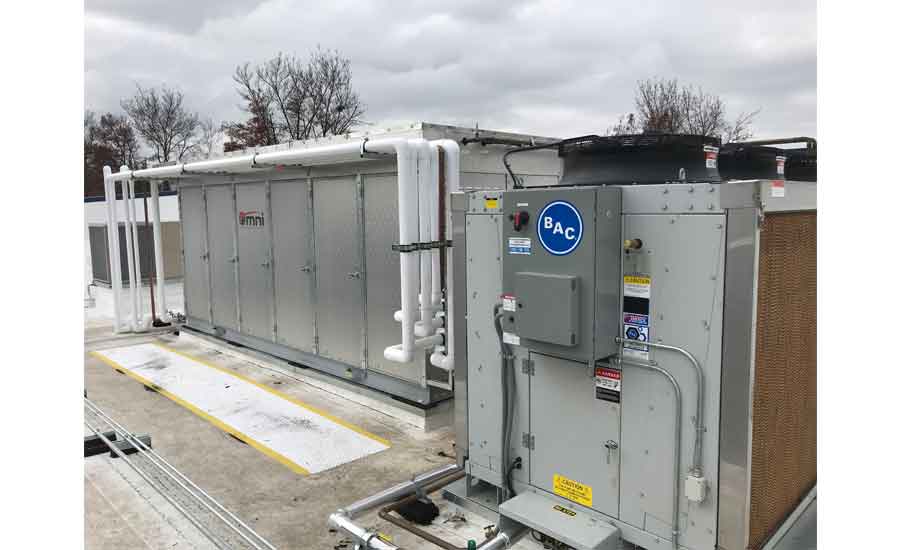
A Beginner’s Guide to CO2 Refrigeration Systems
Natural refrigerant is becoming increasingly popular in wake of environmental regulations.

Refrigerant regulations are becoming more stringent, particularly in states such as California, where starting next year, there is a 150-GWP limit for new or fully remodeled facilities that utilize commercial refrigeration equipment containing more than 50 pounds of refrigerant. The federal government has not yet adopted this low GWP limit, but it could be on the table. Right now, the Environmental Protection Agency (EPA) is in the process of figuring out how it will administer the phasedown of HFC production and consumption in the U.S., and the final regulation should be finished by October.
Many food retailers have been considering their refrigerant options for several years, and when looking for alternatives under 150 GWP, CO2 is usually a top contender. With a GWP of 1, it is environmentally friendly and will likely not be phased out in the future; however, CO2 does operate at a much higher pressure than traditional HFC refrigerants, which may cause concern for both contractors and end-users. For contractors who have worked with CO2 for years, proper preparation and working closely with the OEMs go a long way to alleviating the fear factor.
Getting Started
CoolSys, which is headquartered in Brea, California, and is the parent company of refrigeration and HVAC services companies nationwide, is involved with the design, installation, and/or service of CO2 systems on a daily basis, said Bryan Beitler, vice president and chief engineer at CoolSys.
The company designed and installed its first CO2 system in 2010 in a supermarket in Southern California. The design was a subcritical system with an R-134a top cycle over CO2, and the system combined a scroll parallel low-temperature rack and a pumped CO2 supply for low- and medium-temperature fixtures. CoolSys was the Engineer of Record for the refrigeration and mechanical plans for the project but also worked very closely with the rack OEM, as it was their rack design that was incorporated into the project plans.
Since this was their first CO2 installation, CoolSys personnel traveled to the OEM’s facility with their mutual customer to review design details. The OEM was also on-site during installation and start-up and was critical in making sure CoolSys was aware of any nuances that were new or foreign to the field technicians, said Beitler.
“We tried to surround ourselves with as many supporting entities as possible to make sure we were prepared in advance and that there were few surprises,” he said. “The first experience is always an exciting one, but it did take an investment in time to thoroughly understand those first projects. It is still ‘just refrigeration’; however, the cycle looks a little different. It is important to visit operating systems, take advantage of what is on the internet for supporting documents, talk to those who have had experience, and rely on the component manufacturers to support their products. Repetition goes hand-in-hand with comfort levels, so the more you install and the more technicians that are involved, the greater the comfort level.”
The first transcritical CO2 system that South-Town Refrigeration & Mechanical (STRM), Brooklyn Park, Minnesota, installed was in 2017, and it was an application for a meat processing facility that had 10,000 square feet of processing with two coolers and one freezer. The system was set up to used chilled water through a city water loop, which made it the perfect application for efficiency, said Ryan Welty, vice president of STRM.
To prepare for this first installation, STRM had the OEM help design and engineer the system, as well as train their technicians. The company also hired the OEM to come in for startup in order to assist as needed.
“Overall, we were prepared and ready to address any issues as they came,” said Welty. “We are now designing and/or installing CO2 systems monthly across our entire footprint. We have installed six systems over the past couple of years and expect to install three or more in 2021.”
At Omni Mechanical Solutions in Livermore, California, the OEMs primarily design the CO2 systems that the company installs. Most of these are loop systems, said Joe Tenca, president and CEO of Omni Mechanical Solutions, and his company usually installs an average of one system a year. In order to prepare for the first installation, he and his staff took a training course provided by an OEM.
“CO2 systems aren’t that much different than HFC systems,” he said. “They run at a higher pressure but are similar in design to a lot of the old two-stage systems that used to be common in the marketplace. In addition, there are safety and relief valves all over the system to prevent a mishap from happening. They also are 100% controlled by control systems that monitor all of the systems activity from the rack to the cases and coils.”
What To Know
Welty agrees that while there are not too many differences between CO2 and HFC systems, there are a few that need to be considered.
“A CO2 system will force the end-user to their maximize control strategy through the use of electronic valves,” he said. “It will also be a loop piping system with small diameter piping, which means that on an installation, the electrical contractor needs to work with us more closely to ensure everything is set up correctly from a controls standpoint. Installing the pipe for the project should go a bit faster, though, as it is a smaller pipe and there is less of it due to it being a loop system.”
Beitler added that while the heat transfer process is still quite similar between CO2 and HFC systems, there are some unique items related to safety, system pressures, and the refrigeration cycle that are worth noting.
“As CO2 is a higher pressure refrigerant, it is important for the designer and installer to select and install the correct pressure rated components to match the system design,” he said. “Tubing, valves, and all components must be rated for use in a higher pressure application. The designer must understand the proper components to specify and also provide clear design details to ensure that there is an uninterrupted path to the safety relief valve for the refrigerant to follow in the event of a pressure excursion. Finally, electronic expansion valves (EEVs) are used exclusively in DX applications, so a controls plan must be incorporated that provides an emphasis on fixture controls for each evaporator.”
Indeed, CO2 systems use a great deal more electronic controls than HFC systems, as EEVs are used at all of the fixtures. For that reason, Tenca said that contractors should make sure their technicians are comfortable and proficient in working on control systems.
Many of the same installation techniques that are used for traditional HFC refrigerants apply to CO2 as well, but according to Beitler, the following tips will help ensure a smooth installation:
-
A clean system is paramount, so always purge with nitrogen in the right proportion;
-
If high-pressure iron copper piping is used, ensure that all fittings and tubing are of a high-pressure rating. When pressure testing, test pressures must align with the ratings of the system;
-
Have a helium leak detection system available prior to evacuation in order to locate hard-to-find leaks;

-
Charging methods are somewhat different than chemical refrigerants, so make sure that there is adequate vapor pressure in the system prior to introducing liquid, or the resulting dry ice formation inside the system may ruin your day;
-
Make sure the correct grade of CO2 is used. Most manufacturers recommend Coleman grade, which has a purity level similar to beverage-grade CO2. The supply chain may not always have backup Coleman-grade CO2 available, so it is important to talk with customers about establishing a backup charge;
-
To maximize evaporator efficiency, ensure that the case controllers are performing correctly upon start-up, as this sets the tone for good product temperatures and efficient operation. Depending on the case controller manufacturer, each valve may have a transducer, suction temperature sensor, and coil inlet and outlet temperature sensors to calibrate and check.
If all this sounds too complicated or confusing, rest assured that it really isn’t, said Welty. Especially if contractors and technicians take advantage of the training programs offered by most OEMs.
“At first, our technicians were intimidated by CO2 systems, but once they got it running, they realized it isn’t any different and that they have the skills and abilities to work on these systems,” he said. “If you’re new to CO2 systems, take your time and think about everything you are doing. Use the method of ‘measure twice and cut once,’ and do not be scared to call for help or ask questions of others.”
Contractors should also not let fear of new technology dissuade them from learning about CO2 systems, because they will be a big part of the future in both commercial and industrial refrigeration, said Beitler. He added that the keys to mitigating any fears or nervousness include having the proper training, tools, and equipment; making sure that technicians have a lifeline to reach out to when they get into a jam; providing basic safety and system operation instruction in advance; and finally, repetition.
“These systems are safe, the installation techniques are similar to chemical refrigerants, and the systems control and operate quite well,” he said. “All aspects of working with CO2 systems have been rewarding and challenging, but our company has been fortunate enough to operate along the leading edge and gain experience and knowledge of these systems as they evolved.”
Transcritical and Subcritical
Most of the CO2 systems installed today are either transcritical or subcritical. These terms refer to the state of the high-pressure side of the system, so essentially, a transcritical system operates above the critical point (87.8°F and 1,070 psi) and a subcritical system operates below the critical point.
Transcritical systems were introduced to the U.S. market over the last five years, said Bryan Beitler, vice president and chief engineer at CoolSys, and they have allowed the industry to apply CO2 in warmer climates without having to use a subcritical top cycle if used with adiabatic gas cooling or ejector systems. This eliminates having to have a separate refrigeration top cycle, which may be a cost factor.
“There have been energy considerations that are being studied related to operation in transcritical mode versus subcritical,” he said. “Where the cost-effective balance is between climate zones, hours of transcritical operation, and first costs associated with a transcritical system versus subcritical system are being studied by many. More data is needed for those who are making design and life-cycle cost decisions to use as guidance. From an overall cost of operation perspective, the more hours a transcritical system runs subcritical, the more favorable the energy costs will be.”
Some end users have also looked at the pool of trained CO2 service technicians in a particular area as part of the process in determining which system to install, added Beitler.
Source (Partial): the NEWS

Hinterlasse einen Kommentar